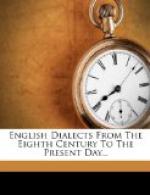The West Midland does not greatly differ from the East Midland, but it approaches more nearly, in some respects, to the Northumbrian. The greatest distinction seems to be in the present and past participles of verbs. In the West Midland, the present participle frequently ends in _-and_, as in Northumbrian, especially in the Northern part of the Midland area. The East Midland usually employs _-ende_ or _-inge_ instead. In the West Midland, the prefix i- or y- is seldom used for the past participle, whilst the East Midland admits it more freely. In the third person singular of the present tense, the West Midland favours the Northern suffix _-es_ or _-is_; whilst the East Midland favours the Southern suffix _-eth_. The suffix _-us_ appears to be altogether peculiar to West Midland, in which it occurs occasionally; and the same is true of _-ud_ for _-ed_ in the preterite of a weak verb.
There is a rather early West Midland Prose Psalter, belonging to the former half of the fourteenth century, which was edited for the Early English Text Society by Dr Karl Bulbring in 1891.
The curious poem called William of Palerne (Palermo) or William and the Werwolf, written in alliterative verse about 1350-60, and edited by me for the E.E.T.S. in 1867, seems to be in a form of West Midland, and has been claimed for Shropshire; nothing is known as to its author.
The very remarkable poem called The Pearl, and three Alliterative Poems by the same author, were first edited by Dr Morris for the E.E.T.S. in 1864; with a preface in which the peculiarities of the dialect were discussed. Dr Morris showed that the grammatical forms are uniform and consistent throughout, and may be safely characterised as being West Midland. Moreover, they are frequently very like Northumbrian, and must belong to the Northern area of the West Midland dialect. “Much,” says Dr Morris, “may be said in favour of their Lancashire origin.”
The MS. which contains the above poems also contains the excellent alliterative romance-poem named Sir Gawayne and the Green Knight, evidently written by the same author; so that this poem also may be considered as a specimen of West Midland. For further particulars, see the “Grammatical Details” given in Dr Morris’s preface to The Pearl, etc., pp. xxviii-xl. Sir Gawayne was likewise edited by Morris in 1864.
It would not be easy to trace the history of this dialect at a later date, and the task is hardly necessary. It was soon superseded in literary use by the East Midland, with which it had much in common.
CHAPTER IX
FOREIGN ELEMENTS IN THE DIALECTS
There is a widely prevalent notion that the speakers of English Dialects employ none but native words; and it is not uncommon for writers who have more regard for picturesque effect than for accuracy to enlarge upon this theme, and to praise the dialects at the expense of the literary language. Of course there is a certain amount of truth in this, but it would be better to look into the matter a little more closely.




